Product Overview
Ground Frame Column
The Ground Frame Foundation System provides a solid, stable, and efficient foundation that captures and preserves the supporting strength and natural functions of the Earth’s soil and provides a connection to the structure above.
Important Note:
- Ensure all permits have been obtained.
- Check for buried utilities, mark on site as per local building codes.
- Have all required tools and equipment outlined below.
- Wear proper personal protective equipment (PPE).
Horizontal Pipe Distance
Measured from horizontal center of anchor bolt to vertical pipe end limit


Ground Frame Column (GFC-125) and (GFC-200) Overview


Internal Components for GFC-125 and GFC-200
(Parts are colored for visual purposes only, all parts have a galvanized finish)
Ground Frame Smart Part Numbers
Simplify field inventory checks using our smart part numbers.

Suggested Crew and Tools

Three-person crew for beam installation, two-person for column

Site transit level

Electric driving hammer (60 lb or greater) with driving bit

Sledgehammer or post driver

Small level with magnetic edge

Torque wrench, 3-3/4″ deep socket, Ratcheting wrench, 10″ extension

Drill and impact driver

Square-edge shovel required for column installation
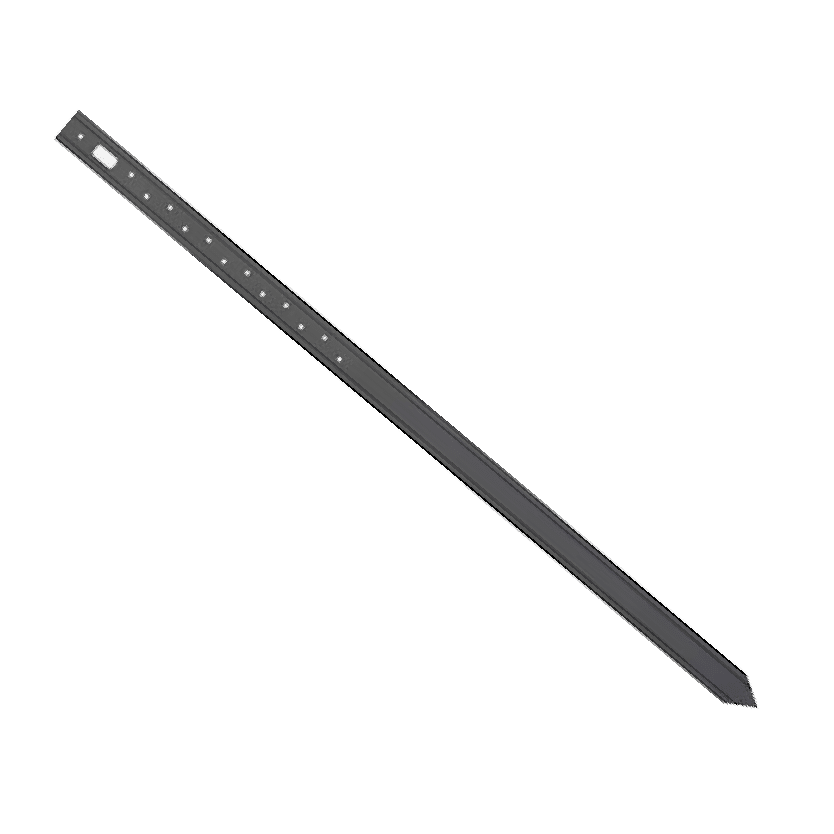
Steel Stake (36″ length)
(Use for batter boards and for plumbing beams)

2 Pipe Wrenches
(Use heavy duty pipe wrenches that will go over the outside diameter of the pipe)

Driving Log
Download Driving Log Template
Before You Begin
Check Pipes for Proper Slide

The anchor bolt and force plate are factory set for proper pipe slide, but may have altered during shipping and handling.
Pipes should easily slide through holes. If pipes do not easily slide, loosen locking bolt. Do NOT force the pipes through the beam/ column holes.
If the bolt is fully loosened and the pipes do not easily slide, contact Ground Frame customer service.
Do |
Don’t |
| Follow the instructions in this guide | Proceed without reading this guide |
| Use only specified hardware | Substitute hardware |
| Review troubleshooting tips to safely remove pipes or adjust pipes | Force pipes past obstructions |
Site Preparation
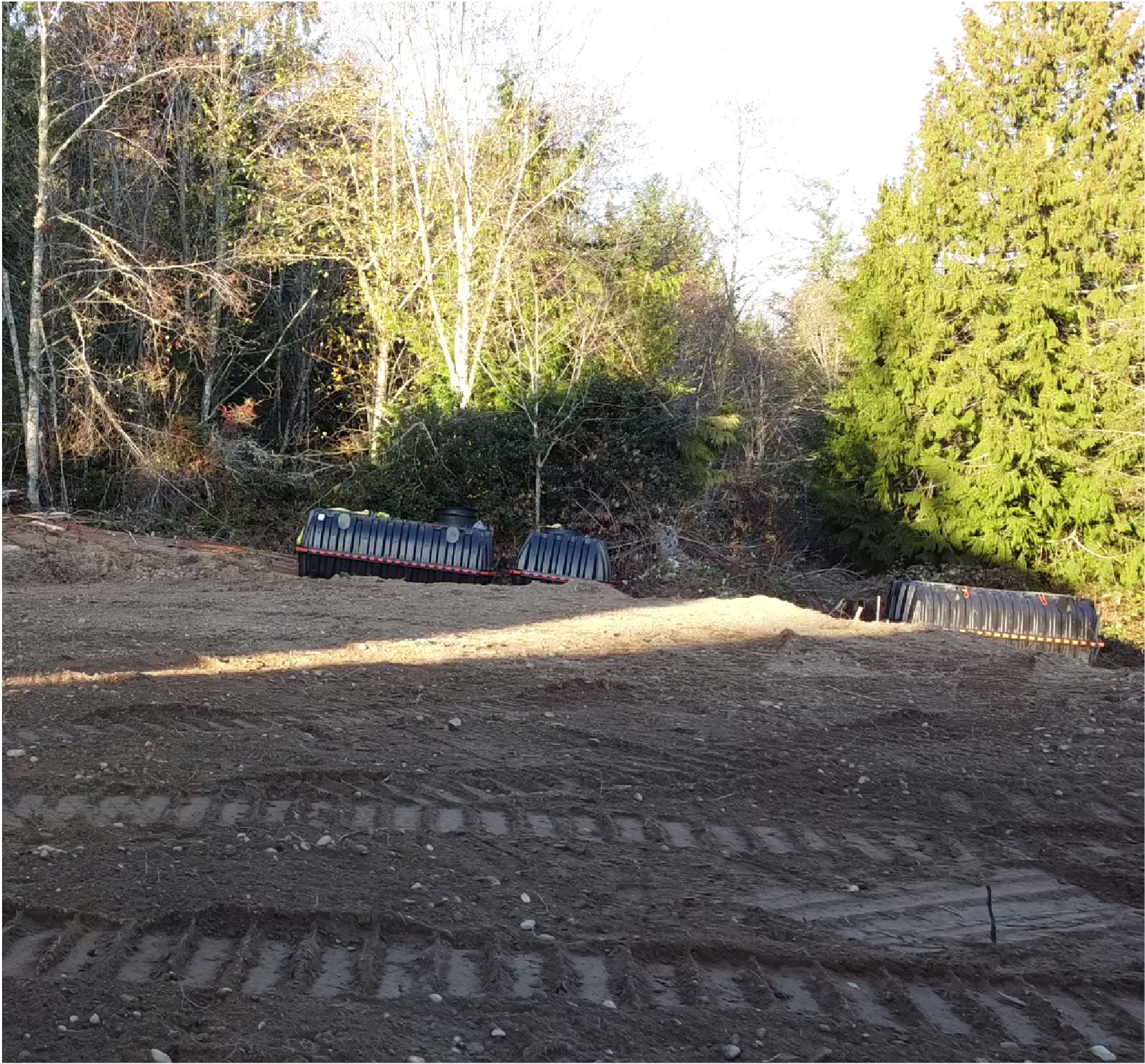
1. Clear and level site as per approved plans. Ensure proper site drainage and desired floor height. Note: For sloped sites, leveling is not required.

2. Using the dimensioned layout as a guide, establish the building border with a string line. For sloped sites, see addendum.

3. Measure diagonally to ensure the border is squared.

4. Find the elevation of a “Master Corner” (the highest corner).
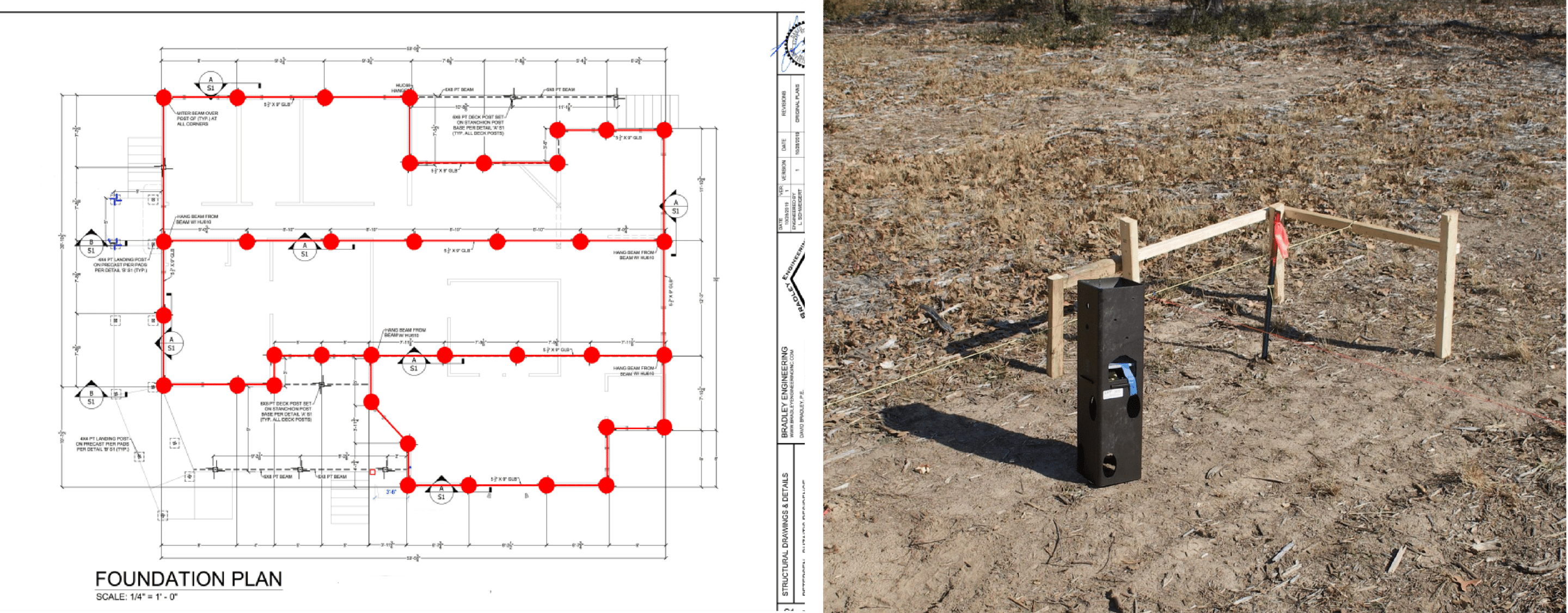
5. Using the dimensioned layout, roughly stage the Ground Frame columns. It is best practice to start in the corners.

6. Dig a 12″x12″ flat bottom square hole large enough to accept the column. Compact soil on the bottom of hole for a firm base.

7. Sit columns in hole.

8. Hand set pipes in respective driving holes, approx. 9” deep.
Note: Placing pipes immediately after column setting, keeps columns on layout and vertical.

9. Verify all outer dimensions according to the dimensioned layout. Ensure steel columns are plumb, level, and square to the overall layout.
Tip: Using a metal pipe inside column to manipulate column until it’s level/plumb.
Pipe Installation

Ground Frame strongly recommends using a minimum two-person crew for pipe driving, to keep it level and plumb.
Ground Frame pipes are not refusal driving systems. All pipes must be driven to their full length to provide specified bearing, uplift and lateral capacities.

10. If pipe does not easily slide, loosen the nut.
Important Installation Tip: Wrap tape around the first few threads of the anchor bolt to ensure bolt does not fall out of the column.

11. Prepare the driving log. Download Driving Log template

12. Using a sledgehammer, drive the pipe in a few inches, to maintain the proper angle.

13. With one person holding the pipe up, drive the pipe through the side driving hole, using the jackhammer with the pipe driving bit.
Tip: The person holding the pipe being driven should also hold the pipe on the opposing side so they can ensure proper pipe angle while simultaneously keeping the column level and plumb.
Note: If, while driving one pipe in, the column begins to tip, move to the opposing pipe and drive it in. Keep track of partial drive times in driving log.

14. Stop driving prior to bit hitting the column.

15. After each pipe installation note time in driving log schedule.

16. When pipe hits an obstruction, follow the troubleshooting steps found below.

17. Using a 10″ x 1/2″ drive extension, torque all bolts to 55 ft. lbs.

18. Place Stand Off Plate inside of column.

19. To determine the floor plane, locate the highest corner.
Note: Builders transit is recommended versus a laser.
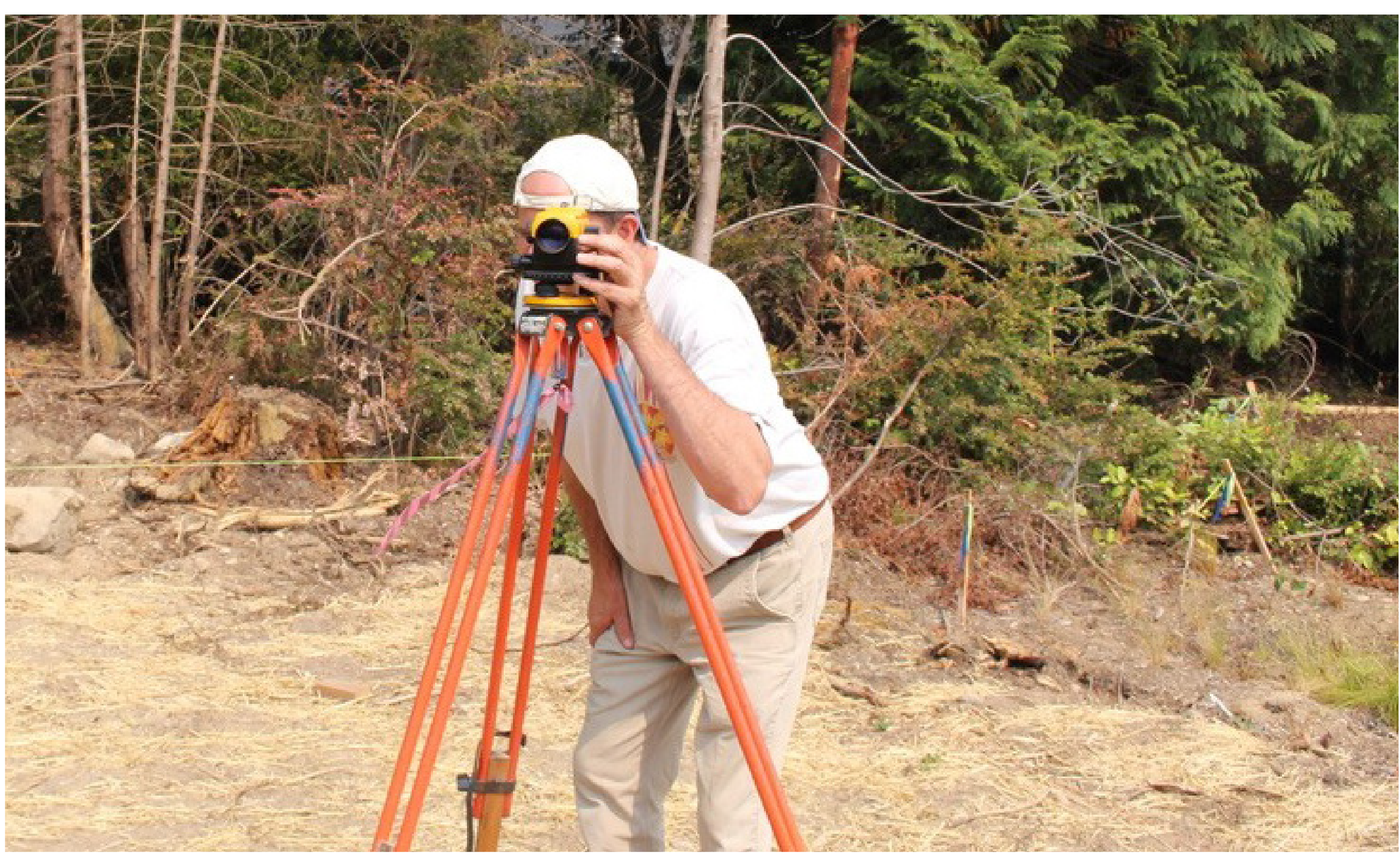

20. Using a survey stick (recommended), measure from the Stand Off Plate in the highest corner to determine proper post height.

21. Cut posts to required height. Secure posts by screwing in lags. Ensure posts are plumb, level and on string to ensure a level floor plane.

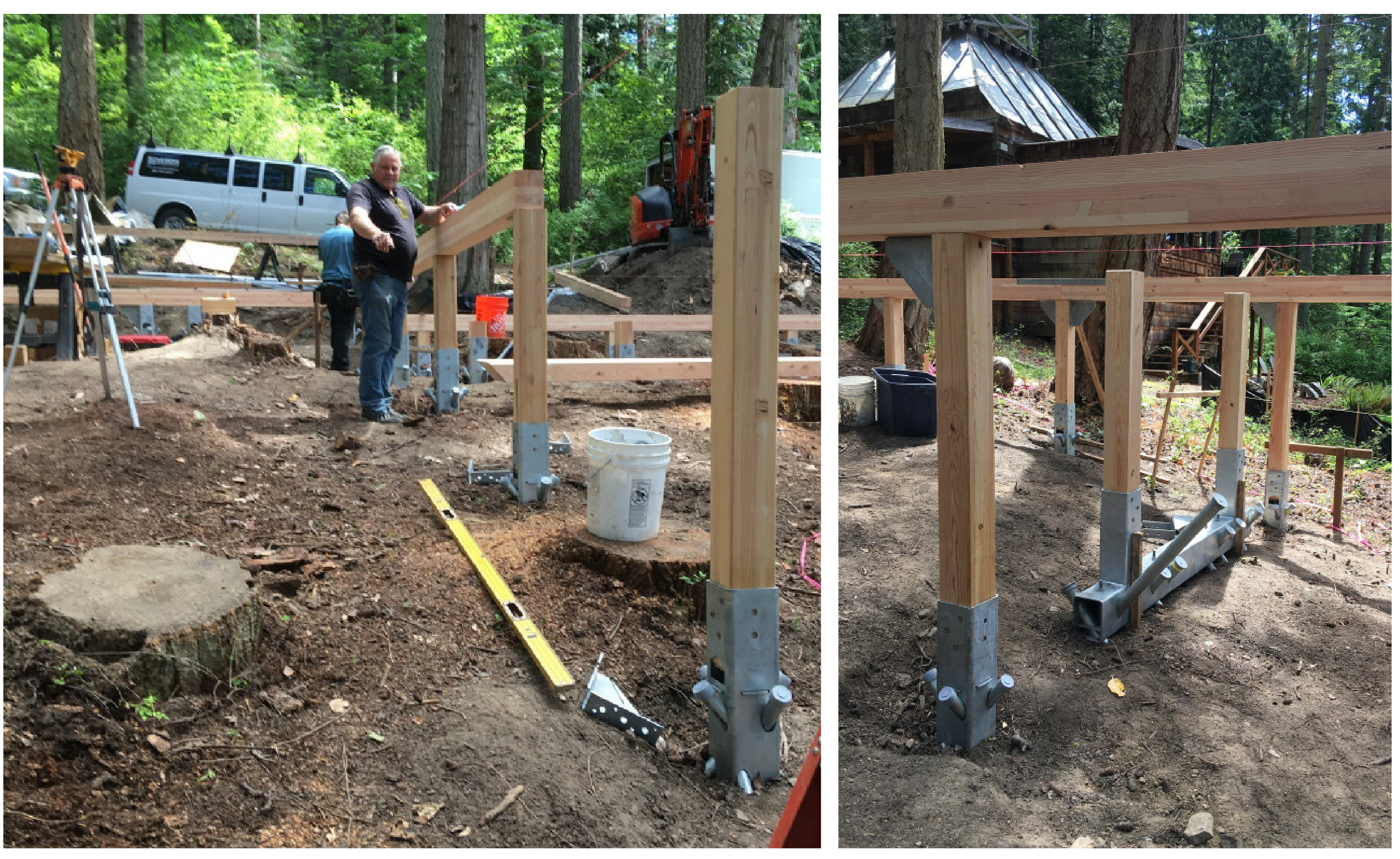
Installation Note: Posts will not always be the same height depending on slope.

22. Install pipe caps on top of each pipe.
Troubleshooting
Shallow Obstruction: ~ 1/3 Pipe Length in the Ground

1. Remove pipe.
Tip: Simultaneously spin and pry pipe, using two pipe wrenches with two people.
2. Remove obstruction and recompact soil in 6″ lifts.

3. Redrive pipe.
Deep Obstruction: 2/3 Pipe Length in the Ground

1. Using a sledgehammer, strike the pipe, 3-5 blows, to ensure pipe refusal.


2. Cut the remaining portion of the pipe, above the Ground Frame beam, and cap.
Important Note: Indicate the length of the pipe that was cut off in the driving log.

Sloped Site Addendum

Sloped lot with Ground Frame beams


